The first thing most people do when they wake up is wash their face, hands, and mouth in the bathroom. Well, long before running water or in-house plumbing became a thing, this simple task wasn’t so straightforward. People had to make do with a washstand and washbowls with pitchers. The invention of indoor plumbing in the 1900s gradually put a stop to the use of these sets.
Today, many homeowners use the washbowl and pitcher sets as aesthetics. They get selected based on their designs or markings. Some prefer to have their vintage washbowl and pitcher sets complement the space’s decor, while a few go for only the beautiful and expensive sets. For some, collecting vintage washbowls and pitchers is a pastime.
If you pay a visit to a collector’s home, it won’t be out of place to find a washbowl and pitcher set in each room. Of course, they are not being used; however, every collector appreciates the historic charm offered by vintage pieces. Some even go all the way by including a washstand.
You probably know all about the washstands, thanks to our previous posts. This guide will focus more on the washbowls and pitchers found on the washstands.
Table of Contents
What Is A washbowl And Pitcher
Antique collectors refer to these items as early bathroom items. The washbowl and Pitcher set was created for personal hygiene hundreds of years ago. They are used for washing one’s body. The first washbowl and pitcher set was produced some time in the 18th century. Pottery companies saw that this set was an effective solution to solving the plumbing challenge.
In those early days, the washbowl and pitcher were often placed close to a window for easy disposal of used water. First of all, water was carried with a bucket or a kettle to fill the pitchers. The pitcher was more or less a tap, while the bowl was the dumping container. After washing or when full, the bowl is emptied by throwing the water out the window or carrying the bowl itself outdoors. Some homes that had quite a number of bowls emptied each into a slop jar (an enormous container).
Reports say Napoleon had a solid gold washbowl and Pitcher set that followed him through his battles. The middle to lower class had sets produced from ceramics and bone china. While the wealthy preferred fanciful, hand-painted sets made from cut glass or even sterling silver. Like most antique items, the rarest washbowl and pitcher sets can be seen in museums and in books.
Many wash basins and pitchers come in 6—12 piece sets. More often than not, they were placed on washstands in the bedrooms. To protect the walls and washstand tops from water stains, small quilt-like cloths were placed hanging behind and beneath the sets.
These exquisite and handy sets stayed helpful up until the twentieth century. Although, you can still find them in use in remote, rural, or underdeveloped regions in the world.
Styles of Antique wash bowls and Pitchers
Antique wash bowls and pitchers can be distinguished based on their designs. During each era, the makers of pitchers and washbowls included made hand-drawn designs that were inspired and styled by the trends at the moment.
Antique wash bowls and Pitchers During The Edwardian and Victorian Era
During the Edwardian and Victorian eras, makers of antique wash bowls and pitchers incorporated artistic styles that featured bright colors and expressive paint strokes to describe the prosperity and high fashion that trended.
A quick look at online antique stores like 1stDibs will give you an idea of how wash bowls and pitchers made From 1837 to 1910 looked. Almost all items during this period looked alike; the tell-tale difference was the material used. Some were made from ceramic, while others were earthenware and faience. Today, these beautiful works of art are used as a piece of furniture in living rooms and bedrooms.
Antique washbowl and pitcher from the Victorian era (1837-1901)
Price: $100
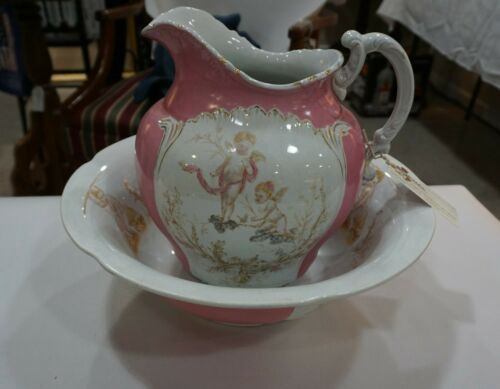
Antique Wash Bowls and Pitchers During The Art Nouveau Era
Recently sold antique art nouveau styled washbowl and pitcher
Price:$120
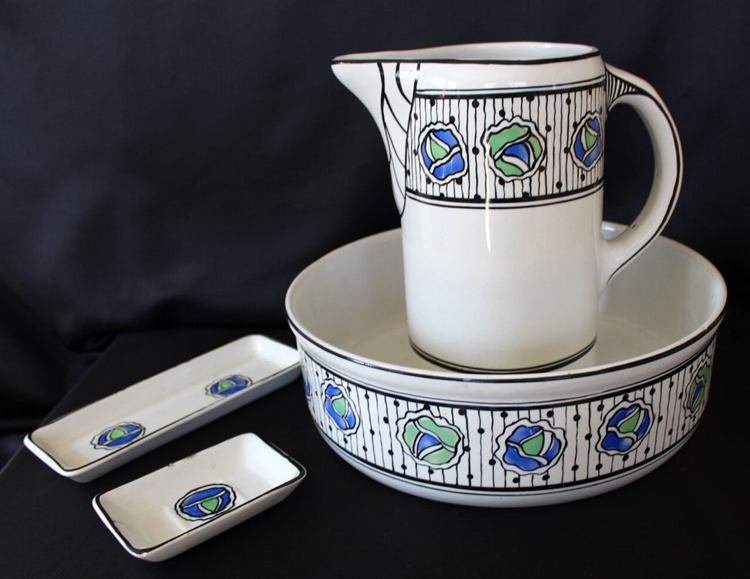
Most of the wash bowls and pitchers produced during this period are similar to the photographed item above. The designs featured muted colors like dark green and olive, geometric and asymmetrical lines, human silhouettes, and plant forms.
Art Nouveau Porcelain washbowl and pitcher set.
Produced in 1932 and is still in excellent condition.
Price: $150
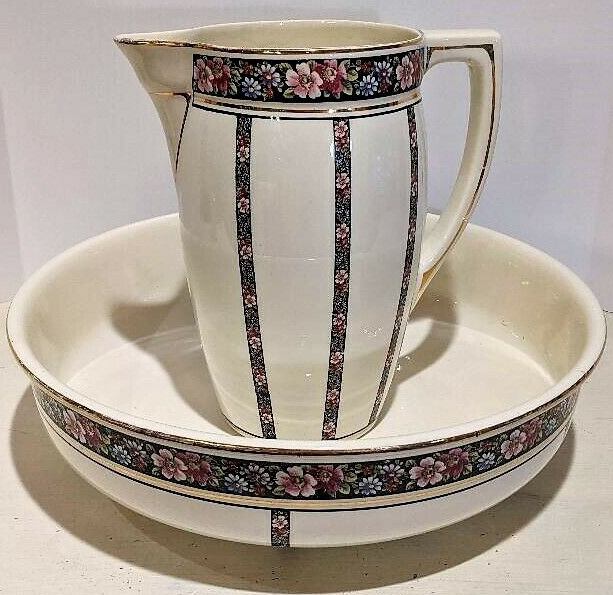
Identifying Antique wash bowls and Pitchers
Identifying antique wash bowls and pitchers is a necessary skill for collectors. Before you give up hundreds of dollars for an item, you must be able to ascertain that it’s the real thing.
Over the years, manufacturers have produced reruns of antique washbowl designs. They copied existing designs of antique items to the last dot. Hence, it is commonplace for inexperienced collectors to pay top dollar for fake antiques. The most straightforward method to identify an original antique is to have it valued by an expert antique washbowl and pitcher appraiser. If you find it hard to locate one, an antique pottery or wash stand appraiser would be able to do a good job.
In case you’re unable to connect with an appraiser before the purchase window closes, here are essential factors you can check for to reduce your chances of purchasing a counterfeit.
Aging
Antique wash bowls and pitchers are at least a century old. Irrespective of the material used during production, all antique wash bowls and pitchers always show signs of aging. It could be scratches, dents, worn-off paints, internal discoloration, cracks, or broken rims. If an antique washbowl and its pitcher appear new or in perfect condition, it is highly probable that it is not original.
Material
Antique pitchers and basins were mainly made from porcelain and ironstone. These were handmade/sculpted.
A porcelain pitcher and washbowl. Featuring scroll and floral patterns on a blue and white background. The manufacturer’s stamp “MC” can be found under one of the crowns.
Perfection
Antique wash basins and pitchers are handmade items. They have some uneven features that may not be obvious to an inexperienced collector. For example, the rims could be wider or uneven than usual, or the paintings could be erased. Some have tiny marks due to heavy usage.
Rarity
Antique pitchers and wash basins can either be prized for their rarity or their sentimental value. When an antique is rare, it is unique and hard to get hold of. Rare antiques have higher values compared to antiques that are mass-produced.
In the nineteenth century, most washbowls and pitcher sets were handmade. It wasn’t too often that two items would bear the same design. If you can ascertain that an antique washbowl and pitcher is unique, it is most certainly valuable, especially if it is made from high-quality materials like gold, platinum, or precious stones.
A rare, hand-painted antique washbowl and pitcher produced in England during the nineteenth century.
Price: $300
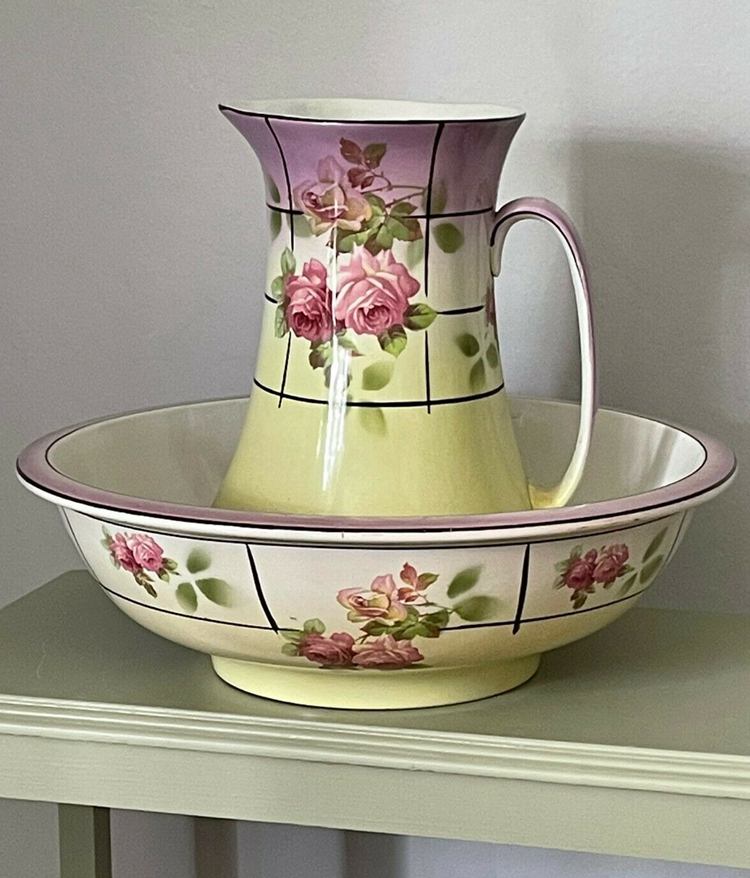
Assessing the value of the antique washbowl and Pitcher
If you enjoy searching through thrift stores, trade shows, or flea markets for collectibles like vintage washbowls and pitchers, or perhaps you have one or more sets of these vintage pieces, it’s best you have an idea of the actual value before you buy or sell.
Antique pitchers and washbowls are historical sets that command higher prices when sold together. The most valuable antique washbowl and pitcher brands include Crown Ducal, Black English Ironstone, McCoy, Roseville, and Frankoma.
Multiple features determine the cost or value of valuable antiques. Before you even consider figuring out the accurate value of the item, you first have to confirm the item is old enough to be called vintage or antique. Once you’re sure, the following points will teach you how to discover the item’s worth.
Confirm its authenticity
To determine the authenticity of a vintage, check for manufacturers’ marks and signatures. At least half of the available vintage washbowls and pitchers today were handmade about 100 years ago. The creators often included their markings on the bottom of the bowls and pitchers. You could also check the hidden parts of both items for subtly made markings.
You need to remember two things. One, not all items without markings are worthless. Second, it is all too easy to duplicate markings. Just because your item is marked with Frankoma’s or McCoy’s stamp does not mean it is a genuine antique. The mark is merely the first stage in advertising the source of your set. If you find any mark on the washbowl or pitcher, the next thing will be more research. For example, a few years ago, a lady enquired if her pitcher engraved with “Silkstone 1907” was the real deal. It wasn’t. It turned out it was a reproduced set that imitated the Silkwood 1907 pattern. One can only wonder how many unsuspecting customers bought into the lie.
To put it simply, you have plenty of research to do to confirm the marks are authentic. You could save yourself the stress and hurdles of this by seeking out the services or advice of an expert.
Analyze the condition of the set
As with all antique items, the more pristine your washbowl and pitcher are, the more they can fetch. Antique wash bowls and pitchers mostly have uneven details. If you’re studying a set of washbowls and pitchers, check to see if it was handmade or not to have an inkling of the state it was produced. Be aware that you can add a bit of touch-up paint to hide scratches, although it’s best not to. Leaving it the way it is will preserve the value of the item.
Check for Manufacturers’ Markings
Product stamping is not a new thing. Manufacturers started adding their marks to products right from the early days (pre-1900). On antique wash bowls and pitchers, you can spot markings, stamps, or hallmarks at the base of both items. However, not all antiques bear marks.
When you find an unfamiliar mark on your washbowl or pitcher, consult a good antique guide or any other reference material that could point you in the right direction.
Vintage markings alone could let you know whether you’ve got the perfect antique or not. A marked antique fetches more money because it specifies the exact maker and sometimes year. It is easier to determine the price of a priced set than an unmarked set.
Notable Manufacturers of antique wash bowls and pitchers
Minton, Sarreguemines, Johnson brothers, McCoy, Roseville, and Longchamp, were outstanding makers of antique wash bowls and pitchers in the 1800s and 1900s.
Minton Antique Wash Bowls and Pitchers
Here is a washbowl and pitcher set produced in 1865 by the Minton Ewee company. This item is still in good condition. It has no cracks, chips, or replaced parts.
Minton manufacturers stamp their marks and production date on both the washbowl and the pitcher.
Price: $1,000
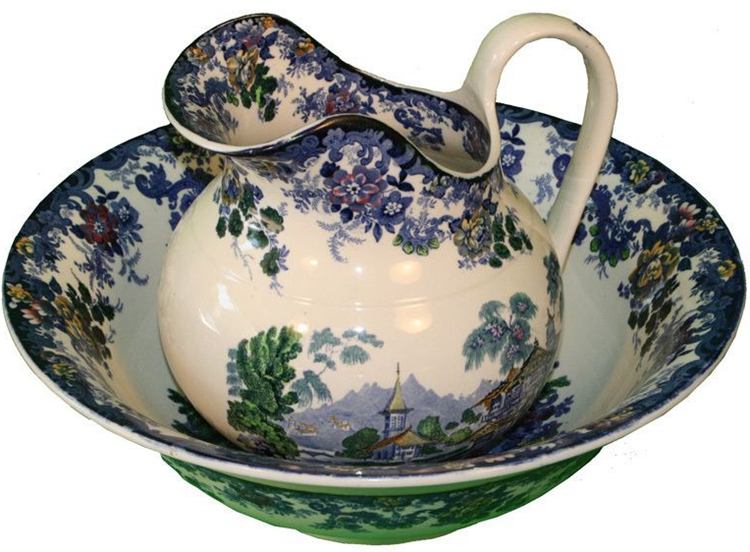
McCoy Antique Wash Bowls and Pitcher Sets
McCoy is a famous American-based pottery company with a rich history. The company was founded in the early 1900s by Nelson McCoy. The styles of wash bowls and pitcher sets produced by this company before it closed down in the late 1900s were inspired by fashions and trends at the time. McCoy antique wash bowls and pitcher sets are precious, specifically the limited designs.
Rare McCoy Wash bowl and Pitcher set
Price: $100
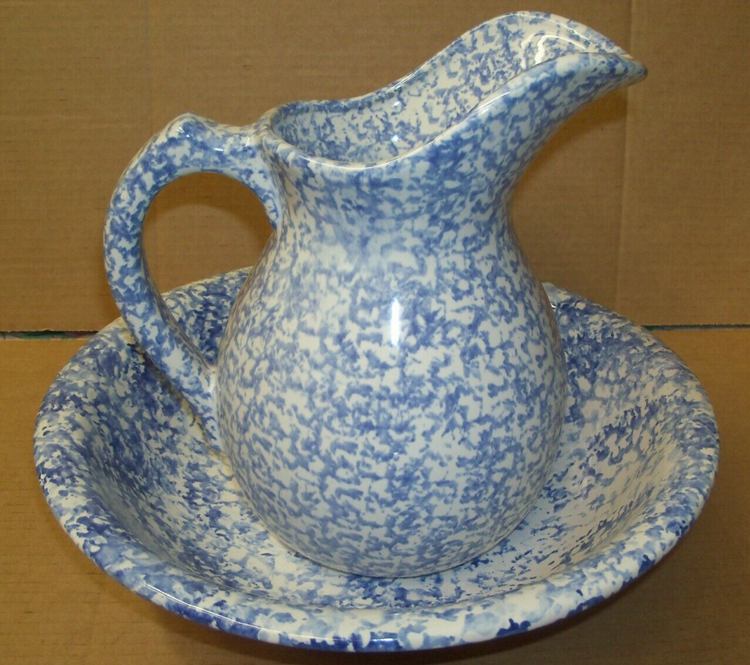
Sarreguemines Antique wash bowls and Pitchers sets
This is a pottery company based in France. Their hallmark was stamped to the bottom of their l ceramic wash bowls and pitcher sets.
One of Sarreguemines stamps used between the 1800s to mid-1900s
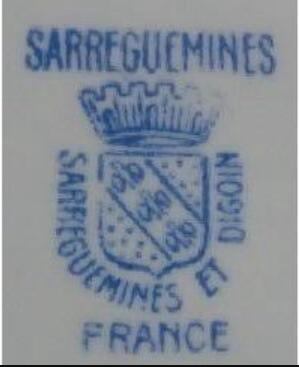
A Sarregue
Price: $60
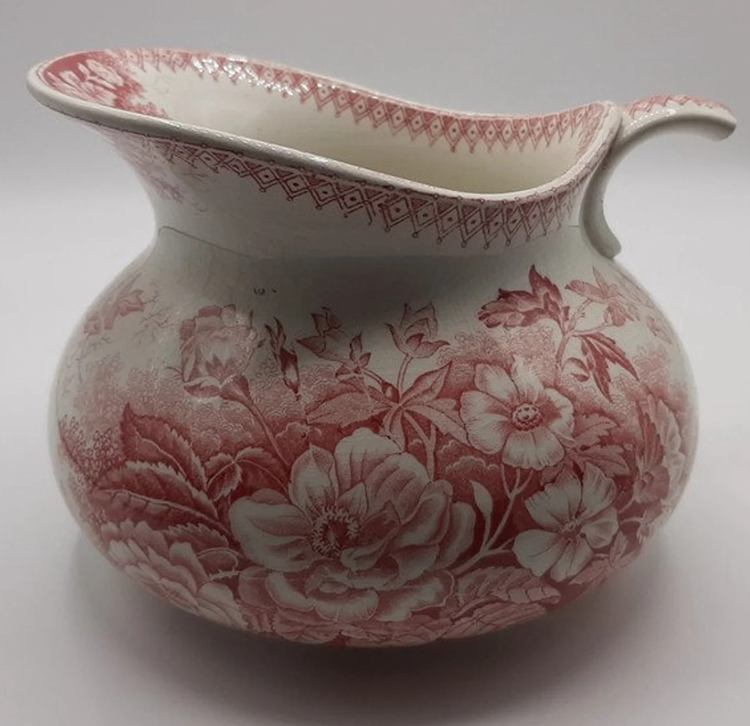
Where To Buy Antique wash bowls and Pitchers
There are dozens of locations you can visit to do your antique shopping. We’ve compiled a complete list of the best places and websites for authentic wash bowls and pitchers.
Estate Auctions, Flea Markets, and Antique Stores
Brick-and-mortar antique stores are not hard to find. A quick search on Google Maps should reveal the closest antique stores to your location. On the other hand, estate auctions are not a regular event. A few tips to know about estate sales include:
- Regularly search for “estate sales” within your location. Craigslist and Estatesales.net are usually well updated on estate sales within different states,
- Follow estate sales and auctions pages on social media platforms like Facebook and Instagram,
- Search through newspaper ads.
- and look out for local fliers advertising antique estate sales.
Not all estate sales or flea markets would have pitchers and washbowls, so try to ask the organizer beforehand.
If you can’t go through the stress and hassles of walking aroud hunting for antique wash bowls and pitchers, you could stay in the comfort of your home and shop online.
Amazon: If you’re seeking any vintage and antique item, not only wash bowls and pitchers, Amazon is one of your best bets for locating the item. This e-market space offers hundreds of antique items for your shopping and window-shopping pleasure. All you have to do is search for “antique washbowl and pitcher” and glance through the listed items for sale. On Amazon, you can find antique items within your budget. If you have a high budget or a low one, there are so many options here.
More so, you could also list your collectible items for sale at a price of your choice.
150 years old antique washbowl and pitcher set
Price:$1,800
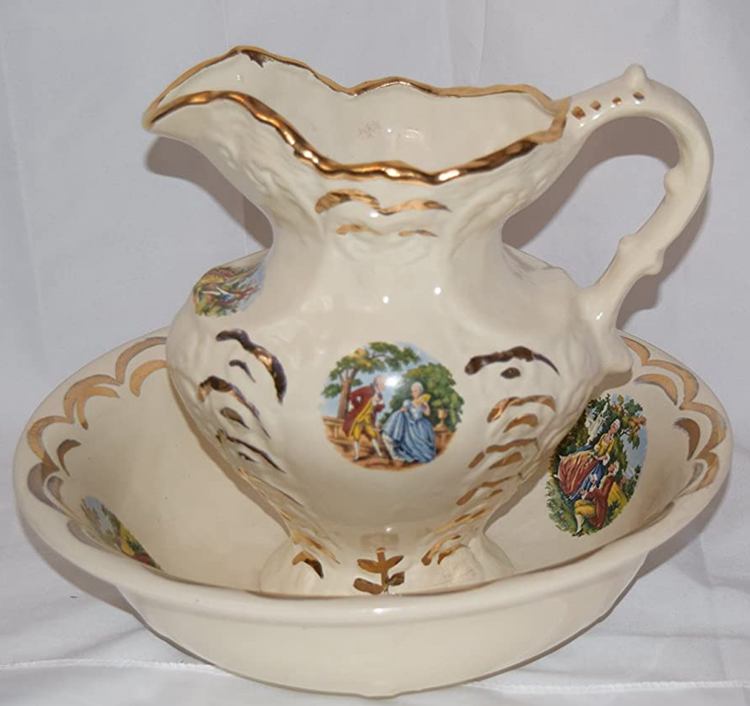
Craigslist: If you’re looking for a website that provides listings of antique items, including wash bowls and pitchers, you should check out Craigslist. The website also offers information about scheduled estate auctions and sales.
This popular website has a page dedicated to antiques and vintage listings. You can go straight to this page to check out your preferred washbowl and pitcher style.
Price: $50
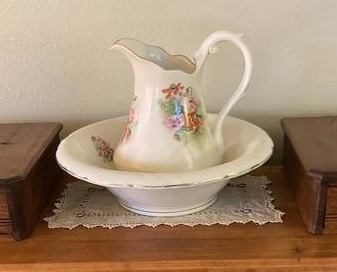
Etsy: Another excellent website to purchase antique wash bowls and pitchers is Etsy. This site is no doubt the best for vintage items. To view pitchers and washbowls on this site, visit their “art & collectibles” section. Here, you’ll come across fantastic wash bowls and pitchers sporting designs from different eras before the 21st century. In fact, the listings are endless.
Ruby Lane: Ruby Lane is a great online store specializing in only antique collectibles. Every item on this platform is either antique or vintage. They also have a strict code of conduct that ensures all listed items are authentic. Additionally, there’s a return policy on all items sold.
eBay: eBay is a widely known online marketplace with millions of daily users buying and selling different items.
Like the websites mentioned above, eBay offers vintage and antique collectibles like washbasins and pitchers.
In fact, this marketplace is one of the most preferred platforms for antique transactions. Millions of people from different regions of the world use this online marketplace for advertising or purchasing valuable collectibles. Prices of wash bowls and pitchers on eBay are as low as $10. The average price of antique wash bowls and pitchers is around $70. Some rare collectibles can go as high as a thousand dollars.
In all honesty, eBay is one of the best places to find pre-used antiques like water bowls and pitchers.
Cross-section of eBay’s antique wash bowls and pitchers category
Shopify: If you’ve looked through the above and you’re yet to find a suitable antique washbowl and pitcher—highly unlikely—it is time to check out hosted antique stores on Shopify. Shopify is another prominent virtual marketplace like Etsy, Amazon, and eBay. The significant difference is that if you’re a collector looking to sell some antique pieces, you’ll be required to pay a standard fee to open a store.
Anyways, you can check out the available stores here for your beautiful, authentic vintage and antique wash bowls and pitcher.
A list of antique stores hosted on Shopify

Price Comparison
Everyone deserves a fair price. What better way to know if you’re getting a reasonable price than by comparing prices with completed others. When you compare prices, you have more chances of finding good deals.
eBay has a category of “sold items’ ‘ and “completed orders.’ These categories can be used to compare prices. You have to check out the categories and look for similar antique wash bowls and pitchers to get an idea of how much yours would cost.
You could also procure the services of an appraiser to give you a breakdown of how much similar items cost. Your local libraries may also have reference guides you could use.
Note that when comparing prices, you must factor in the condition of your antique, whether or not it is better than the already sold item; if you find a similar washbowl and pitcher set in the eBay completed others category, you have to check the condition it was sold in. This would determine whether or not you can increase or decrease the price of your item. For example, if your antique has several imperfections like hairline cracks and breakages, it cannot be sold at the same amount as a perfect washbowl and pitcher set was sold.
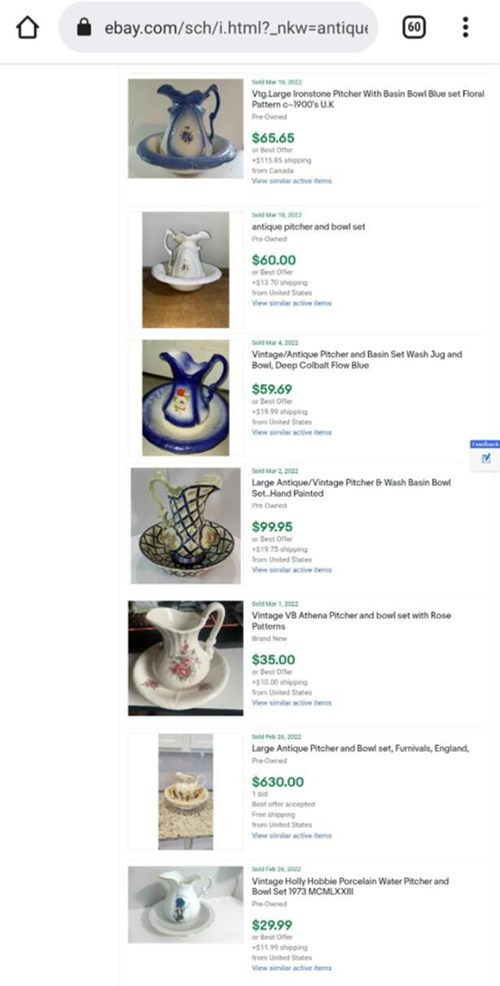
There you have it!
All there is to know about antique wash bowls and pitchers: with the above information, you can conveniently purchase an authentic antique wash bowl at reasonable prices. You know where to shop (online; eBay, Etsy, Amazon, etc., and Offline; estate sales, antique stores), what to check for (aging, material, makers), and how to ascertain you’re paying the correct amount (price comparison).
For more information on how to care for or know more about antique wash bowls and pitcher sets, we have listed additional resources.







![Where To Sell Antique Furniture In 2022 [Ultimate Guide]](https://www.jacquelinestallone.com/wp-content/uploads/2022/09/Etsy-Your-Place-To-Buy-And-Sell-All-Things-Handmade-600x450.jpg)


